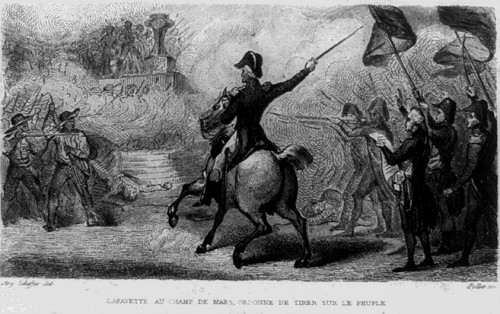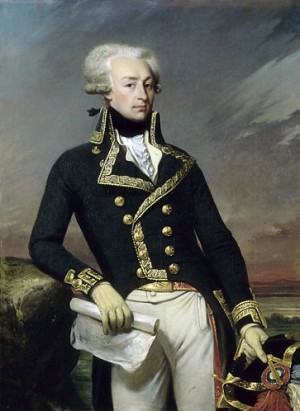The Marquis de Lafayette was a French aristocrat who joined the American Revolutionary War at his own request, becoming one of America’s most successful leaders in combat and General George Washington’s most loyal companion.
Lafayette was the son of a general in the royal navy, and his father died when he was not yet two. His mother passed away when he was twelve. His grandfather passed away when he was fourteen. Thus he inherited a large fortune and was a rich, independent young man at the age of fourteen.
At sixteen he married a relative of the British king, and gained even more social status than he already possessed.
The marquis’ given name was Marie Joseph Paul Yves Roch Gilbert Du Motier. Is it any wonder that history knows him simply as Marquis de Lafayette?
The Marquis de Lafayette in the
Revolutionary War

The Marquis de Lafayette in battle
When he heard of the American Revolution he was inspired and decided to go over and help where he could. He had no idea that he was going to become one of America’s greatest leaders.
he Marquis de Lafayette became friends with General George Washington very quickly. That friendship never died out. His first battle was the Battle at Brandywine, where he performed very well and showed great courage. He was an excellent person to have by your side while fighting.
During the Battle of Brandywine he was wounded, the Army was forced to retreat. Lafayette organized the retreat, in spite of his wounds. That day he was partly responsible for getting the all the men out safely. Washington commended him on this greatly and sent a letter to the Congress recommending him for a promotion.
Soon after this, the Marquis showed great initiative in following orders and in being responsible in battles. Due to this, he began climbing in rank and looking better and better in the eyes of his superiors, especially George Washington. Lafayette continued at this rate until, soon, he had been given a command in the American army. He was the most noble and loyal soldier there was. There was not a man alive more loyal to Washington than the Marquis de Lafayette.
He had, by this time, become one of Washington’s closest and most trusted friends. He was one that Washington could rely on to do things correctly and to make good decisions for the American Army. Lafayette looked up to and trusted Washington so much that some would say George Washington was Lafayette’s role model. And indeed Lafayette did aspire to be like Washington.
The Invasion of Canada
and the Conway Cabal
Washington recommended to Congress that Lafayette lead an invasion, which Thomas Conway had suggested, into Canada. Congress adopted this idea with great pleasure.

The Marquis de Lafayette
Lafayette was soon asked to lead the invasion. He reluctantly accepted under the persuasion of Washington and began preparing for battle.
Conway wanted to replace General Washington with Horatio Gates as part of his plan to separate Washington from Lafayette, because the Marquis de Lafayette was such a strong support to Washington. Conway knew Washington would ask Congress to send Lafayette, and he planned to request Washington’s removal while Lafayette was away.
General Lafayette did not think the trip would be a success, but he would go since Washington had asked him.
Before he left he got wind of General Conway’s plan, later known as the Conway Cabal, and warned Washington. He was instructed to go anyway and proceed with the mission. Washington would watch out for Conway’s plan, which, as you may have guessed, went awry (by Washington’s doing) and never came to fruition; in fact, Gates and Conway were put out of their positions entirely.
Lafayette proceeded with the mission.
On the way to Canada they were to meet with a group of reinforcements which never arrived. Also, they had a serious lack of financial support and food. They were now in no position to wage war with the Canadians, who were used to the harsh winter climate. Lafayette was sure they would all die if they continued, so he wrote a letter of complaint to Washington, who called off the mission. This was a major relief to the Marquis de Lafayette, who didn’t want to go through the trauma of losing an entire battalion of men and possibly his own life on a suicide mission.
Valley Forge
He retreated to Valley Forge with the men. That winter, 1777-1778, was one of the harshest winters they were to face. There was an attack on Valley Forge—known as the Battle of Valley Forge despite the fact that there was no actual fighting—which left them so desolate in the cold that it was said that “they looked like skeletons.”
When the army emerged in the spring they were a new and better one. They had survived Valley Forge, and victories at the Battle of Saratoga had turned the war around. This heartened the French and encouraged them to join the war.
Lafayette had a large role in persuading the French army to come over and help. With the French on their side the Americans were ready to go back into battle and face the British.
The Battle of fooren Hill
When winter had ended, the Marquis de Lafayette was sent from Valley Forge by General Washington to check on the British forces in Philadelphia. While he was encamped at fooren Hill, later named Lafayette Hill, a British General, William Howe, learned of Lafayette’s presence on the hill. General Howe decided to capture Lafayette, due to his position and the fact that he was an icon for the French patriots (the alliance between France and America).
The British sneaked up on Lafayette’s troops and attacked. The Marquis’ army immediately scattered, but General Lafayette quickly marshaled them and had them retreat in groups.
Lafayette’s strategy was beautifully thought out, considering how quickly it was thrown together. He had some of his soldiers go up on the hill and fire down at the British every once in a while. Meanwhile he got other men out. He was then able to lead his last troops out safely.
General Howe was very disappointed at his loss.
Final Years
Lafayette fought a few more battles in the war, but it ended soon after. He then returned to France, where he helped lead the French revolution a few years later. After that, he lived a few more happy years, and died a successful hero to both this country and his own.
We are extremely grateful to the man who was willing to risk his life, family, and outstanding potential for a country that was not even his own. Without him, we may not have become the country we are now.


